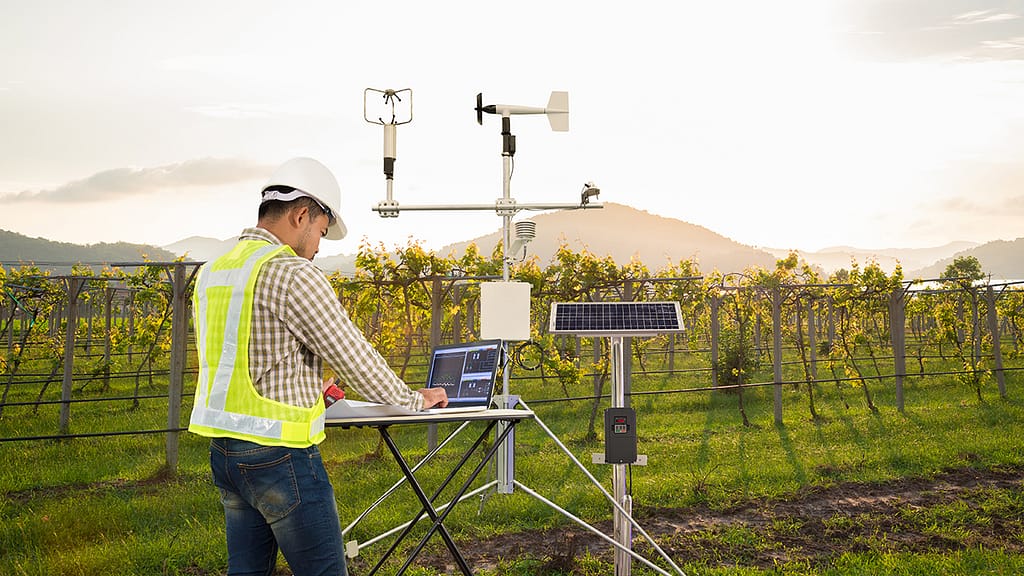The environmental monitoring market has experienced significant growth in recent years, driven by the increasing awareness of environmental issues and the need for sustainable development.
As the government becomes more conscious of the impact of human activities on the environment, the demand for advanced monitoring systems has surged. This holds especially true for companies, which are expected to uphold certain agreements concerning their environmental impact.
Some examples are the World Health Organization guidelines and the newest CSRD guidelines. Both set standards for compliance and monitoring of production, forcing companies to study and minimize their environmental impact.
In this article, we want to explore the environmental monitoring market’s current trends and future outlook, filling your company in on an optimistic scenario that will soon take over industry standards.
Read also: What is an environmental monitoring plan? A brief guide
Environmental monitoring market: current trends

Let’s take a look at the whole picture in front of us.
Technological advancements
The rapid advancement in technology has been a key driver of the environmental monitoring market; innovations in sensor technology, data analytics, and IoT (Internet of Things) devices have revolutionized how we monitor environmental parameters.
Modern sensors are more accurate, durable, and capable of real-time data collection, providing critical insights into air quality, water quality, soil conditions, and noise levels. Advancements in wireless sensor networks and remote sensing technologies enable continuous monitoring over vast areas with minimal human intervention.
The integration of artificial intelligence and machine learning algorithms also allowed for increased accuracy in predictive analytics and automated response systems, enhancing the efficiency and effectiveness of environmental monitoring.
Regulatory requirements
Governments worldwide have implemented stringent regulations to protect the environment and public health. These regulations mandate regular monitoring and reporting of environmental parameters, driving the adoption of environmental monitoring systems.
For instance, the European Union’s Ambient Air Quality Directive and the United States Environmental Protection Agency’s (EPA) Clean Air Act are pivotal in shaping the environmental monitoring landscape.
Compliance with these regulations not only ensures the protection of natural resources but also promotes transparency and accountability among businesses and industries.
The introduction of new policies aimed at reducing greenhouse gas emissions and combating climate change further emphasizes the importance of comprehensive environmental monitoring.
Rising awareness and public health concerns
There is a growing awareness of the link between environmental quality and public health – and this has been a focus in the recent development of the environmental monitoring market.
Poor air and water quality can lead to severe health issues, including respiratory diseases, cardiovascular problems, and waterborne illnesses. As a result, there is a heightened demand for monitoring solutions that can provide real-time data and help mitigate health risks associated with environmental pollution.

Public health campaigns and increased media coverage of environmental issues have played a significant role in raising awareness among the general population. Individuals and communities are becoming more proactive in demanding accurate and timely environmental data, leading to increased investments in advanced monitoring technologies.
Industrial applications
Industries such as manufacturing, oil and gas, and mining are increasingly adopting environmental monitoring solutions to ensure compliance with environmental regulations and minimize their ecological footprint.
These industries require continuous monitoring of emissions, effluents, and other environmental parameters to avoid penalties and maintain their social license to operate, often being at the forefront of the environmental monitoring market.
Advanced monitoring systems enable industries to detect and address environmental violations promptly, thereby reducing the risk of environmental damage and associated costs. By implementing sustainable practices and demonstrating environmental responsibility, industries can enhance their reputation and gain a competitive advantage in the market.
Data integration and management
The integration and management of large volumes of environmental data is also becoming increasingly important. Modern environmental monitoring systems generate vast amounts of data that need to be processed, analyzed, and interpreted to make informed decisions.
Cloud-based platforms and big data analytics are playing a crucial role in managing this data effectively. These platforms enable seamless data integration from multiple sources, facilitate real-time data visualization, and provide actionable insights through advanced analytics.
Read also: What are IoT tracking sensors for?

The future of the environmental monitoring market
The integration of artificial intelligence (AI) and machine learning (ML) is expected to transform the environmental monitoring market. AI and ML algorithms can analyze vast amounts of data collected from monitoring systems, identify patterns, and provide predictive insights.
This will enable a new level of proactive measures to prevent environmental degradation and enhance decision-making processes.
Furthermore, machine learning models can continuously improve their accuracy and efficiency by learning from new data, ensuring that monitoring systems remain adaptive and effective over time.
The expansion of the IoT ecosystem will likely play another significant role in further boosting the environmental monitoring market. IoT devices can be deployed in remote and hard-to-reach areas, providing comprehensive coverage of environmental parameters.
The interconnectivity of these devices will facilitate seamless data sharing and integration, leading to more efficient and effective monitoring solutions. This interconnected network of devices will also enable automated responses to environmental changes, such as adjusting emissions controls or alerting authorities to potential hazards.
And finally, the concept of smart cities is gaining traction, with a focus on sustainable development and improving the quality of life for urban residents. The environmental monitoring market will also contribute to making this dream become a reality.
Environmental monitoring is a core component of smart city initiatives, enabling cities to monitor air quality, manage waste, and optimize resource usage. The growth of smart cities will create new opportunities for the environmental monitoring market.
In smart cities, advanced monitoring systems can be integrated with other urban infrastructures to create a dynamic and responsive environment. Real-time air quality data can trigger traffic management systems to reduce congestion and emissions, while waste management systems can optimize collection routes based on fill levels.
This integration will lead to more sustainable urban environments and enhance the well-being of city dwellers.
Read also: Carbon footprint tracker – how the calculation works

Datanet IoT: everything you need for environmental monitoring solutions and devices
The environmental monitoring market is poised for significant growth in the coming years, driven by technological advancements in environmental monitoring solutions and devices, regulatory requirements, and the increasing focus on sustainability and public health.
As the world grapples with environmental challenges, the demand for sophisticated monitoring solutions will continue to rise, shaping a more sustainable and resilient future. By embracing innovation and leveraging the power of data, the environmental monitoring market will play a pivotal role in safeguarding our planet for future generations.
We here at Datanet IoT are prepared for this future by offering the best environmental monitoring solutions and devices. Contact us today to learn more about our products and services – or check out what we have in store for your business.







